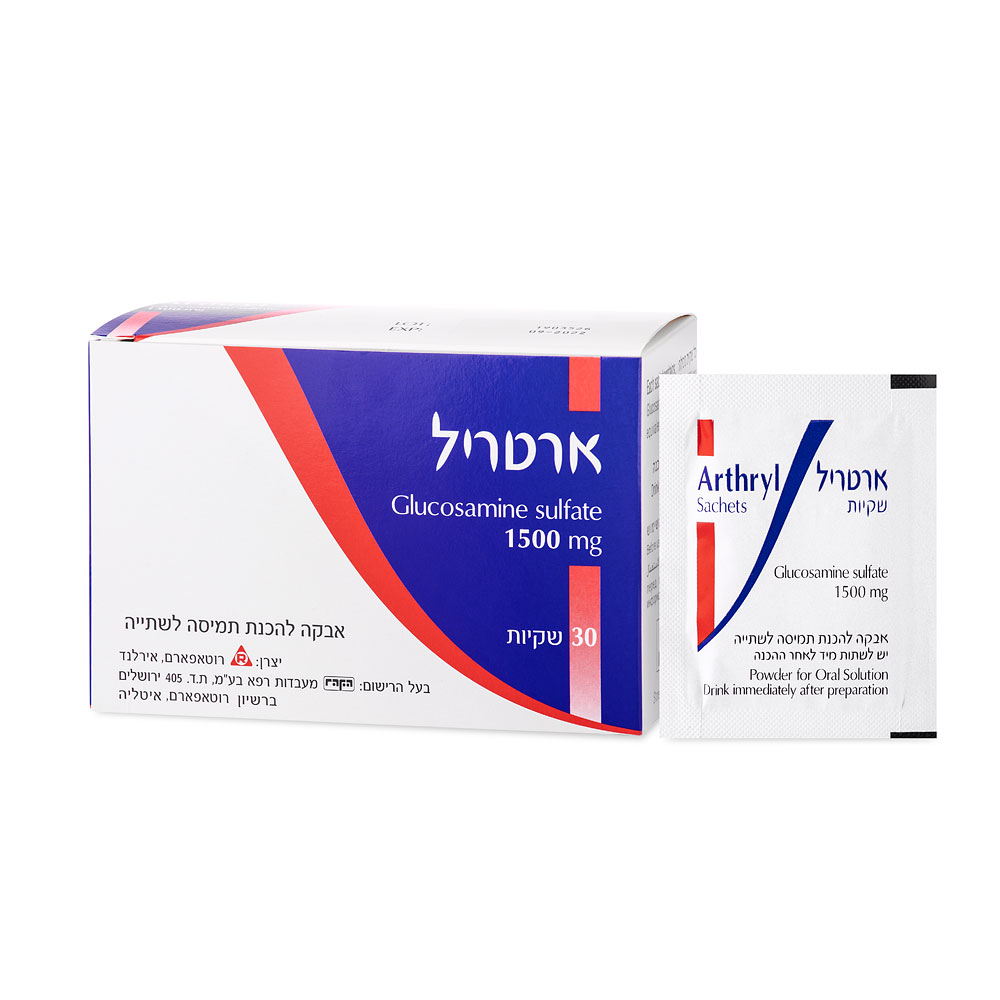Quest for the right Drug

ארטריל ARTHRYL (GLUCOSAMINE SULFATE (CRYSTALLINE))
תרופה במרשם
תרופה בסל
נרקוטיקה
ציטוטוקסיקה
צורת מתן:
פומי : PER OS
צורת מינון:
אבקה להכנת תמיסה : POWDER FOR SOLUTION
עלון לרופא
מינוניםPosology התוויות
Indications תופעות לוואי
Adverse reactions התוויות נגד
Contraindications אינטראקציות
Interactions מינון יתר
Overdose הריון/הנקה
Pregnancy & Lactation אוכלוסיות מיוחדות
Special populations תכונות פרמקולוגיות
Pharmacological properties מידע רוקחי
Pharmaceutical particulars אזהרת שימוש
Special Warning עלון לרופא
Physicians Leaflet
Pharmacological properties : תכונות פרמקולוגיות
Pharmacodynamic Properties
5.1 Pharmacodynamic properties Pharmacotherapeutic group: Other anti-inflammatory and anti-rheumatic agents, non-steroids ATC code: M01AX05. Mechanism of action: Glucosamine sulfate is the sulfate salt of the endogenous amino-monosaccharide glucosamine, a normal constituent and preferred substrate for the syntheses of glycosaminoglycans and proteoglycans in cartilage matrix amd synovial fluid. It stimulates the synthesis of glycosaminoglycans and this of articular cartilage proteoglycans. Pharmacodynamic effects: Glucosamine sulfate has anabolic and anti-catabolic effects on cartilage metabolism. More recent studies have postulated that glucosamine sulfate decreases IL-1 β mediated effects, thus inhibiting a cascade of events that lead to joint inflammation and cartilage damage, such as the synthesis of metalloproteases, cyclooxygenase-2 and extracellular matrix proteins that are absent in normal cartilage, the release of nitric oxide and of prostaglandin E2, the inhibition of chondrocyte proliferation and the induction of cell death. Differently from NSAIDs, glucosamine does not directly inhibit cyclooxygenase activities. Clinical efficacy and tolerability: The safety and efficacy of glucosamine sulfate has been confirmed in clinical trials for treatment of up to three years. Short- and medium-term clinical studies have shown that the efficacy of glucosamine sulfate on osteoarthritis symptoms is evident already after 2-3 weeks from the beginning of administration. However, differently from NSAIDs, glucosamine sulfate has shown a duration of effect which ranges from 6 months to 3 years. Clinical studies of daily continuous crystalline glucosamine sulfate treatment up to 3 years have shown a progressive improvement on the symptoms and a delay of the joint structural changes, as determined by plain radiography. Glucosamine sulfate has demonstrated a good tolerability over both short-term and long- term treatment courses.
Pharmacokinetic Properties
5.2 Pharmacokinetic properties Absorption After oral administration, glucosamine is rapidly and almost completely (about 90%) absorbed systemically in health volunteers. The absolute bioavailability of glucosamine in man after administration of oral glucosamine sulfate was 44%, due to first-pass effect of the liver. It is unknown if meals significantly affect the drug oral bioavailability. The pharmacokinetics of glucosamine are linear after once daily repeated administrations in the dose interval 750-1500 mg with deviation from linearity at the dose of 3000 mg due to lower bioavailability. No gender differences were found in man with regard to the absorption and to the bioavailability of glucosamine. The pharmacokinetics of glucosamine was similar between healthy volunteers and patients with osteoarthritis of the knee. Distribution After oral absorption, glucosamine is significantly distributed in extra-vascular compartments including synovial fluid. Glucosamine does not bind to plasma proteins. It is therefore highly unlikely that glucosamine might produce displacement drug interaction when co-administered with other drugs that are highly bound to plasma proteins. Metabolism The metabolic profile of glucosamine has not been studied because being an endogenous substance; it is used as a building block for the biosynthesis of articular cartilage components. Glucosamine is mainly metabolized through the hexosamine pathway and independently of the cytochrome enzyme system. Crystalline glucosamine sulfate does not act as an inhibitor nor as an inducer of the human CYP450 isoenzymes. No clinically relevant metabolic inhibition and/or induction interactions are expected between crystalline glucosamine sulfate and co-administered drugs that are substrates of the human CYP450 isoforms. Excretion In man, the terminal elimination half-life of glucosamine from plasma is estimated at 15 h. After oral administration of 14C-labelled glucosamine to humans, the urinary excretion of radioactivity was 10±9% of the administered dose while faecal excretion was 11.3±0.1%. The mean urinary excretion of unchanged glucosamine after oral administration in man was about 1% of the administered dose suggestion that the kidney and the liver do not significantly contribute-to the elimination of glucosamine and/or of its metabolites and/or its degradation products. Special populations Patients with renal or hepatic impairment Studies in renal impaired patients were considered irrelevant due to the limited contribution of the kidney to the elimination of glucosamine. Similarly, studies in subjects with hepatic impairment were not conducted given glucosamine metabolic fate as an endogenous substance. No dose adjustment is considered necessary in subjects with renal or hepatic insufficiency. Children and adolescents The pharmacokinetics of glucosamine was not investigated in children and adolescents. Older people No specific pharmacokinetic studies were performed in older people however in the clinical efficacy and safety studies mainly elderly patients were included. Dose adjustment is not required.

שימוש לפי פנקס קופ''ח כללית 1994
לא צוין
תאריך הכללה מקורי בסל
לא צוין
הגבלות
לא צוין
מידע נוסף
